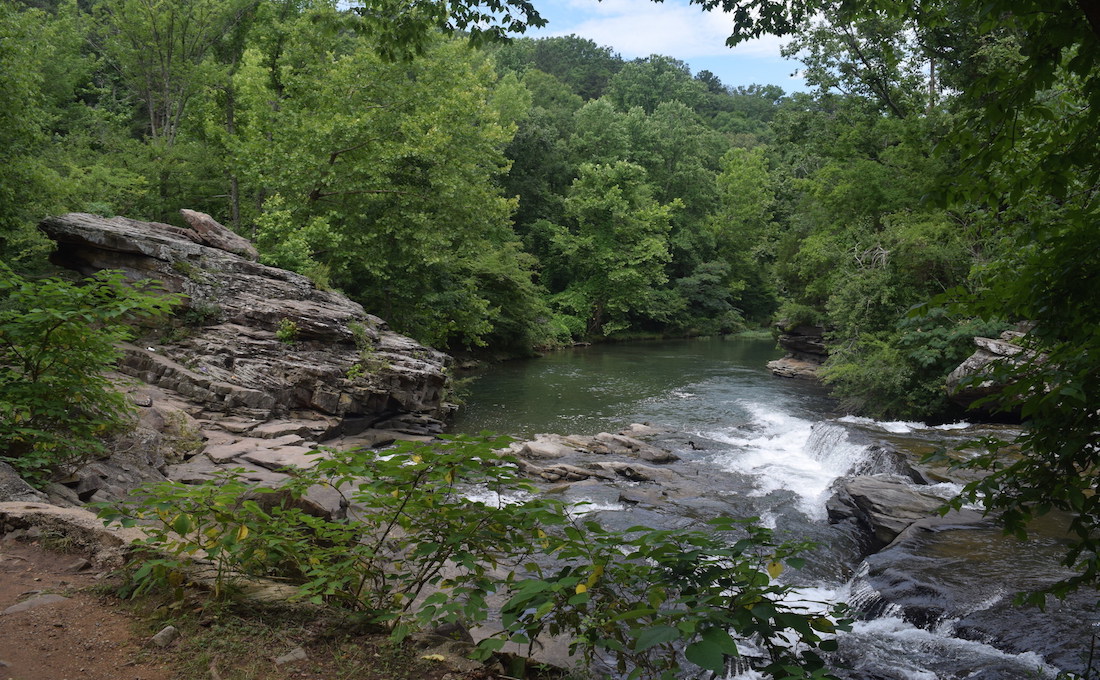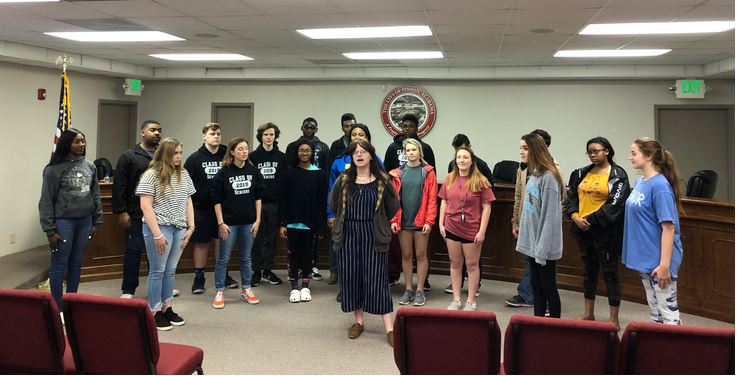With new fundraiser, Turkey Creek Nature Preserve hopes to avoid a bleak future
Still recovering from decades of abuse, the preserve launches campaign to become financially sustainable — and to escape closure.
A single pink sock, caked with mud, lies crumpled on the ground in Turkey Creek Nature Preserve, just a few yards from the water’s edge. Charles Yeager — a bearded man whose khaki shirt, embroidered with the preserve’s logo, reminds one of a park ranger — groans as he stoops to pick it up.
“Every week we go through about 20 garbage bags,” he says, walking the sock over to a nearby bin, which itself is nearly overflowing with empty soda bottles and styrofoam cups. He tosses the sock in. “That’s how much trash we’re dealing with, if not more.”
There’s nobody at Turkey Creek today. It’s a Monday, which means the preserve is closed to the public. (It’s also closed on Tuesdays and after 5:30 p.m. the rest of the week.) On these days, the entrance to the preserve is blocked by a large wrought-iron gate with a sign warning away potential trespassers.
Among other things, this day off allows Yeager, the sole manager of the 466-acre stretch of land in Pinson, time to clean up the remnants of the weekend’s visitors. Turkey Creek receives an estimated 130,000 visitors yearly, which is calculated by a road counter at the preserve’s entrance. That’s significantly higher, Yeager says, than the 40,000 visitors per year Turkey Creek received when he started working there in 2012.
As Yeager walks through the preserve, picking up a small collection of bottle caps and rusted pull-tabs, he worries aloud that a time will come when those gates have to be closed for good. There are eight months left for the preserve to meet a fundraising goal of $500,000.
Turkey Creek has already secured approximately $300,000 of that money in grants and private donations over the past two years. That money will go toward the construction of an on-site pavilion — to host educational programs, but also to be rented out for weddings and similar events — in a bid to make the preserve financially sustainable.
But in order to access that $300,000, the preserve also needs to show that it has three years’ worth of operational funding. The fundraiser hopes to raise that remaining money though small donations from individual donors. If the preserve doesn’t raise that amount, it loses the $300,000.
“People aren’t just going to give us money and then have us close down and have this building that they paid for that nobody can occupy or use,” Yeager says.
If the fundraising campaign fails, he says, the outlook for Turkey Creek’s future “is certainly scarier than it ever has been.”
Yeager lives at Turkey Creek and spends 80 to 90 hours per week maintaining it. He’s the only employee, and part of the funds raised will go toward his salary. He’s paid to work 35 hours a week; the rest of his work is volunteered time. In many ways, he’s the sole reason Turkey Creek stays open at all. The state owns the land, but it’s promised to close it to the public if there’s no one there to maintain it.
“Without somebody here, this place is too much of a liability,” Yeager says. “They will close the gates. Public access can be stopped and will be stopped, because [the preserve] will be destroyed. And nobody’s going to let it go back to what it was. That’s not an option.”
‘An Abused, Forgotten Gem’
He’s referring to Turkey Creek before it was a preserve, back when it was private property with a public road running through it. “It wasn’t really looked after,” he says. “There was no oversight whatsoever, and over the years, it just got rough.”
By the 1980s, the property had become a dumping ground. Photos taken during cleanup efforts show piles of used tires and trash bags scattered throughout the falls area at the heart of what is now the preserve. It had also become a site for illicit activity such as drug deals and prostitution, aided by the property’s relative isolation. There were even murders — in 1995, an 18-year-old and a 20-year-old were shot and killed on the property.
“There were a lot of people coming out, and they realized they could get away with doing whatever they want to do,” Yeager says. “There wasn’t anybody good hanging out down here, really. There might have been, but not very many of them — and they were risking their lives by coming down here for sure.”
In 1998, the Jefferson County Commission began considering Turkey Creek as a different kind of home for criminals, proposing the construction of a $50 million, 900-person, moderate-security prison on the site. The property’s proximity to a wastewater treatment plant was one reason, but the commission was largely drawn to the property as a prison site for the same reason criminals had been: it was isolated.
“It was far enough on the outskirts of the county that it was out of sight,” Yeager says. “It was an incredibly beautiful little gem that’s tucked away and had been abused and forgotten about.”

This photo taken during a 1997 volunteer cleanup effort at Turkey Creek shows the effect of years of abuse. Photo courtesy of the Turkey Creek Nature Preserve.
But Pinson residents took notice of the county commission’s plans — and took action. In response to the proposed prison, several residents started the Society to Advance the Resources at Turkey Creek (START) to attempt to protect the land. The group — which, according to Turkey Creek’s website, boasted 7,000 members — attempted to get the land protected by Alabama’s Forever Wild Land Trust, a state program established in 1992 that acquires land for public use and protects it from future development.
But Forever Wild’s board turned START’s proposals down, citing the derelict state of the property — still covered in trash from years of neglect and abuse — as well as the fact that the property was still divided into three different properties — with three different landowners.
The Jefferson County Commission abandoned plans for the prison at Turkey Creek in late 1998, but START continued its efforts, organizing clean-ups of Turkey Creek that resulted in 300 tons of trash being removed from the property’s falls area alone. In 2001, START partnered with the Freshwater Land Trust, a Birmingham-based nonprofit that worked to obtain and combine the properties that would eventually become the preserve. By 2003, the Freshwater Land Trust had obtained all 466 acres of land, combined it into one property, and once again nominated it for protection by Forever Wild — and this time, it was approved unanimously.
The Freshwater Land Trust sold the land to Forever Wild for $2 million — and after it had recouped the costs of acquiring the land, it put the remaining amount into a bank account to use in setting up the preserve.
“That wasn’t a large amount of money by any means,” Yeager says. “That money was only really meant to last a couple of years, and we just ran out of that money last year. We were able to stretch that money out for eight years.”
Without that money, Yeager says, the preserve must find a way to become financially sustainable or face potential closure. “Our resources are so thin,” he says. “I don’t want to have to beg and plead and not know where we’re going to be every year. I don’t like not knowing if we’re going to be able to have a job to support my family next year. It’s scary, and I don’t want to risk that one year when we don’t have the funding, or we don’t have the support we need to keep the gates open.”
The Financial Puzzle
Turkey Creek operates on roughly $80,000 per year — a shoestring budget, Yeager says. Half of that comes from a slew of partners: the City of Pinson, the Jefferson County Commission, the Alabama State Lands Division, and the Friends of Turkey Creek. Another $15,000 to $20,000 comes from the annual Darter Festival. But the remainder of that budget comes largely fundraising efforts.
A large part of the preserve’s annual budget, goes toward Yeager’s salary. Roughly $6,000 per year goes toward paying for utilities so that the preserve’s office can have power and running water. Then there’s fuel for the preserve’s pickup truck, Kawasaki MULE, lawn mowers, weed eaters, and chainsaws. (“Trees come down a lot,” Yeager says.) Plus there has to be money to pay for repairs when there’s vandalism, to pay for replacements when visitors steal signage — and to pay for all those garbage bags. “Those get expensive,” he says.
But finding funding for Turkey Creek has been made difficult, ironically, by the same entities that keep the preserve open. Because the preserve exists on land owned by the state, any money it could earn from charging admission would go directly to the state’s general fund, not to the preserve.
That inability to charge admission means that the preserve instead has to compete for foundation grants — but that, too, is limited by an entity that keeps the preserve running: Birmingham-Southern College.
While Forever Wild was able to purchase and ensure the protection of Turkey Creek lands, it did not have the resources to actively manage it — so in 2009, the Southern Environmental Center, an educational facility that exists on Birmingham-Southern College’s campus but is financially independently from the college, agreed to take on the task of setting up the preserve’s operational side.
“The key there was the opportunity to have this as a field laboratory for BSC students in [the college’s] urban environmental studies and biology programs,” Yeager says. He’s a graduate of Birmingham-Southern himself (as is, full disclosure, the author of this article).
The Southern Environmental Center co-manages the preserve — a role that, in addition to organizing educational programs at the preserve, involves bookkeeping and providing Yeager’s employment benefits — but because the center, and thus the preserve, are part of Birmingham-Southern’s 501(c)3, Turkey Creek is often restricted from applying for financial grants for which the college is also competing.
That doesn’t mean that Turkey Creek has been completely unsuccessful in getting grant money — in addition to the $300,000 the preserve has raised for the new pavilion, foundations have funded several restoration projects for the preserve, as well as the construction of a greenhouse on adjacent property — but it does limit their already sparse ability to lobby for funding.
“We’re small,” Yeager says. “We don’t have a marketing team. I’m out here cutting the grass and picking up trash. I can’t fundraise and market the way that it would need to be done, because we just don’t have the staff to do that…. So what we’re trying to do is move toward sustainability.”

Yeager stands at the place where the planned pavilion at Turkey Creek will be built. Photo by Sam Prickett.
An Area of “Flexibility”
One small step in that direction is the greenhouse project, which was sponsored by foundation grants. The greenhouse sits on private land, owned by the Freshwater Land Trust, which sits adjacent to the preserve — Forever Wild restricts all development on preserve property — which means that Turkey Creek can keep the money it makes from selling plants out of the greenhouse. That’s a small financial help, but the planned pavilion project would be the preserve’s biggest step toward sustainability.
The planned area for the pavilion is, like the greenhouse, on private land near the preserve. Yeager says that private, non-preserve land “gives us a lot of flexibility.”
“It means we can have special events,” he says. “We can build permanent structures there. We can have utilities there — water and power. We can’t have that in the preserve.”
Even so, Yeager says the planned development will have “the lowest impact possible” on the environment. The planned site has been clear of trees for half a century, so none will have to be cut down for construction. “We’re not going to have a negative impact on the ecology there,” he says.
The pavilion will seat 150 people and will be ADA compliant, allowing the preserve to teach much larger classes of school-aged students. Currently, Turkey Creek’s small classroom — also located on Freshwater Land Trust-owned land adjacent to the preserve — can hold roughly 30 students. “But a lot of schools can’t afford to just bring one class. They need to bring an entire grade,” he says. “We have no place to hold 200 kids. We have to turn down groups when they’re just too large.” (The fundraiser also hopes to pay the salaries of two new part-time employees, who will primarily focus on the preserve’s education programming.)
In addition to the pavilion, there’s a planned parking lot — this accounts for $50,000 of that $500,000 goal — as well as a planned space for restrooms, something the preserve doesn’t have yet. The restrooms will also help the preserve be able to handle large classes of students — the lack of those facilities “is a big deal, and that discourages a lot of groups from being able to come out,” Yeager says. They also help with the pavilion’s secondary goal of being able to host weddings and similar private events.
“We started looking at it, and there’s not a lot of outdoor wedding venues [in the area],” Yeager says. “We get a lot of calls and emails about people wanting to do weddings here, and we just can’t provide that service. So this is an opportunity to have a rental space that can provide sustainable income through weddings, through birthday parties and other events — things we’re just not able to provide at this time.”
He pauses, looking around the clearing. “It’ll be a beautiful spot for a wedding.”
“There’s Just Love for This Place”
Fundraising for Turkey Creek has been particularly challenging, Yeager says, because “it is a complex situation” to communicate to the public. But maintaining the status quo, he adds, is no longer an option.
“The message most people want to hear is all the happy stuff — all the kids, all the families, all the pictures of the happy, smiling fish — but we’ve been doing that for years,” he says. “There’s always been the option to donate. We’ve been begging and pleading with the public through this positive message. But now we have to be realistic.”
The campaign has been met with some skepticism, he says, from those who see it as just a cash grab. Those responses are “disheartening,” Yeager says. “There’s no conspiracy here. There’s just love for this place.”
“It’s important for people to realize something,” he adds. “There’s a misconception that nature takes care of itself. But that’s not exactly the case here. Nature does take great care of itself — when there’s not people disturbing it.”
As he turns to head back to his office, Yeager stops to look at a plastic Coca-Cola bottle floating in the creek, trapped in an indentation in the falls by a shallow eddy of water that spins it around and around. It’s been there since the previous evening, left there by a careless swimmer. Yeager considers the spinning bottle for a moment, sighing.
“I’ll come back and get it this afternoon,” he says. “That one’s not going anywhere.”














George Johnston
July 24, 2018 at 4:37 pm
Good article, Sam. I learned a lot about a beautiful spot in Jefferson County. I have never been there and knew almost nothing about it.